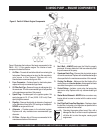
PAGE 32 — MAYCO C-30HDG PUMP — OPERATION AND PARTS MANUAL — REV. #6 (04/02/12)
Down-Hill Pumping
Downhill pumping can be difficult on some jobs. It is suggested that
a sponge 2”x 4”x 6” be placed in the hose before the start of
pumping. Wet the sponge before placing it in the hose. Reference
the Operating Suggestions at the start of this section for slurry
procedures.
The reason for using the wet sponge is to keep the slurry from
running too far ahead of the concrete and so reducing the
possibility of separation. When the pump is stopped, the material
can flow slowly down, due to gravity, and cause the hose to
collapse.
When pumping is resumed, you can expect a blockage at the point
of hose collapse. To prevent this from happening, the hose can be
“kinked off” at the discharge end when the pump is stopped to
prevent the gravity flow of the material in the hose.
The use of stiffer mixes when pumping down-hill will decrease
gravity flow of the material in the hose and will assure a smoother
operation between the cam roller bearing and cam plate. As with
any job, make sure that the hose and the couplings are in good
workable shape.
It is strongly recommended that steel pipe be used
on ALL vertical pumping for safety and conve-
nience.
Valve Seats
If the volume at the end of hose starts to decrease gradually and
eventually almost stops, it is quite likely that the
valve seats
have
had excessive wear and need replacement. Once they have
reached a certain wear point, they may “channel out” rapidly and
material will reciprocate past the ball on each stroke.
The hollow
steel ball
should be replaced when it starts to show
dents or appears to be badly worn. Sand and aggregate materials
in some areas are extremely sharp and hard and therefore highly
abrasive. Under these conditions when pumping stiff mixes, or to
high elevations which cause line pressures, it will be noted that
valve components may have short wear life.
If this condition exists, it is advisable to remove the manifold only,
and inspect the lower seat at the end of each day. If it appears that
the seat is beginning to “channel out", replace before starting the
next day’s pour.
The upper valve seat can be inspected after each washout by
running your finger around lower edge of seat where the ball
makes contact. You can reach this from the inside of the hopper. Be
sure that the engine is turned off.
C-30HDG PUMP — OPERATING INFORMATION
Vertical Pumping
When pumping vertically up the side of a building, above 40 feet,
we would recommend the installation of
steel pipe
securely
fastened at intervals as necessary to support the pipe. Ninety
degree, long radius pipe sweeps should be installed at the top and
bottom of the steel line.
Use a 25 ft. hose, or short section, off the pump; and for the balance
of the horizontal distance to the vertical line, use steel pipe. This
type of installation has been satisfactory on many jobs being
pumped in excess of 100 feet high. Line pressures are always less
using steel pipe as compared to hose.
When pumping vertically using
all hose
, it is recommended not
to go higher than 50 feet with hose. The hose should be tied off at
intervals of 10 feet, if possible. Special attention should be given
when tieing the hose off at the top as the hose will have a tendency
to stretch when filled with concrete. This will increase the possi-
bility of a blockage at the point where the hose is tied off. To avoid
this, a long radius of 90 degree elbow is recommended. The
suggested place to tie off is on the hose, under the clamp.
Pulsation
A slight pulsation of the hose will always be noticeable near the
pump. Excessive pulsation of the hose near the pump is normally
due to higher than average line pressures caused by stiff, harsh
mixes, or extremely long pumping distances.
The use of 2 -1/2” I.D. hose in these extreme cases reduces line
pressures or the addition of slight amounts of water to the mix, if
permissible, will permit easier pumping. The use of certain pump-
ing admixtures may help.
If excessive pulsation exists in the hose, it is advisable to use
burlap or some means of wear protection under the hose at points
where the hose may wear through the outer cover; e.g. over forms,
steel or sharp curbs.


















